Oils and greases have a very destructive impact on rubber.
To protect rubber components in the conveyor belts from swelling, types of rubber that are resistant to oil and grease should be applied.
Since not all oil and grease types are equally aggressive, the engineers have developed different types of belts to meet all the requirements.
| Designation | Elastomer | Hardness
±5 Sh°A |
Abrasion max. (mm3) |
Swelling of covers in oil; measurement according to standard ASTM D471 | ||||
|
Testing condition
|
IRM 901 | IRM 902 | IRM 903 | |||||
| RMG PLUS |
NBR/SBR | 65 | 130 | 22h /70°C | RC | 3% | 10% | 20% |
|
MOR |
NBR/SBR/BR |
61 |
130 |
22h /70°C | RC | 5% | 15% | 30% |
|
MG PLUS |
NBR/SBR |
65 |
150 |
22h /70°C |
RC | 3% | 10% | 20% |
|
GMG SUPRA |
NBR |
63 |
100 |
22h /70°C | RC | 10% | 5% | 5% |
|
KMOR |
NBR/BR |
60 |
150 |
22h /70°C |
RC | 3% | 10% | 20% |
|
KGMG |
NBR |
62 |
200 |
70h /100°C | RC | 5% | 5% | 20% |
Applications
- Concrete plants
- Recycling and mineral processing plants
- Waste sorting and compost machines
- Metal processing industry and scrap recycling
- Timber industry and sawmills
- Excreta and sewage sludge conveying
- Corn, rape and soilages conveying
- Paper industry
- Fertilizers handling

